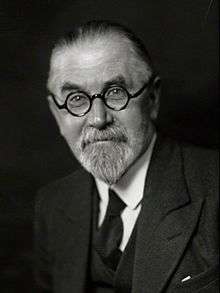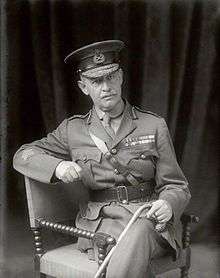Walter Stoneman
| Walter Stoneman MBE | |
|---|---|
 Walter Stoneman, self-portrait, April 1942 | |
| Born |
6 April 1876 Plymouth, England |
| Died |
14 May 1958 (aged 82) Horley, Surrey, England |
| Nationality | British |
| Occupation | Photographer |
| Employer | Russell & Sons |
| Known for | Providing ca. 7,000 portrait photographs to the National Portrait Gallery |
Walter Ernest Stoneman MBE (6 April 1876 – 14 May 1958) was a British portrait photographer who took many photographs for the National Portrait Gallery (NPG) in London.
Career as a photographer
Stoneman was born in Plymouth, Devon on 6 April 1876, the second youngest of fourteen children of Edwin Stoneman, who ran a wholesale grocer's business. He went to school at Plymouth College, which he left when he was fifteen in order to embark on a career as a photographer. He later had his own photographic business in Plymouth, Heath and Stoneman Ltd., but most of his career was spent working for the London firm of J. Russell & Sons, which he had joined as a junior photographer by 1897.[1]
In June 1897, he was the only one of fourteen photographers working for J. Russell & Sons who succeeded in taking four pictures of Queen Victoria in her golden state landau on the occasion of her diamond jubilee.[1] Working for J. Russell & Sons, he took numerous photographs of royalty, aristocracy, members of high society and other prominent individuals. By 1913 he became Managing Director of the firm, and after the death of John Lemmon Russell in 1915 he ran the company. In October 1932 it was absorbed into Elliott & Fry.[2][3] In 1961, Walter Bird (1903–1969) purchased Russell & Sons and became its leading photographer; he sold the company to Godfrey Argent in 1967.[4]
In 1948 Stoneman was made a Member of the Order of the British Empire (MBE) for services to photography. He continued working as a photographer right until his death in 1958.[1]
Stoneman was a fellow of both the Royal Photographic Society and the Royal Geographic Society, as well as vice-president of the London Devonian Association. He was also a lay preacher in the Congregational church. He was married to Kathleen Irene (b. 1892), and had one son.[1]
National Photographic Record
In 1917, in collaboration with the National Portrait Gallery, Stoneman launched a project to build a National Photographic Record (NPR) of all prominent members of British society. Over the next 41 years Stoneman took and printed postcard-sized pictures of some 7,000 individuals in his studio, between 100 and 200 a year, and provided them to NPG.[2] The project focussed on political and military figures, and sitters included five monarchs, nine prime ministers, twelve lord chancellors, eighty admirals and one hundred generals. Sitters did not pay for the privilege of being photographed by Stoneman, but were photographed for free at the studios of J. Russell & Sons at Baker Street, and so Stoneman was not directly remunerated for producing the photographs.[1]
The original idea of Stoneman was for storing visual records rather than distributing them. However, parts of the collection were occasionally exhibited to the public, for example at the Royal Photographic Society in 1922 and 1924, at the studios of J. Russell & Sons in Baker Street in 1931, and at Foyles Art Gallery in 1943. The fees collected from such exhibitions and from reproductions of the photographs were shared between Stoneman and the NPG. These exhibitions also helped boost his reputation and increase his clientele.[1][5]
Up until his death Stoneman had been the sole official photographer for the NPR. After his death, the NPR project continued with Walter Bird as photographer until 1967, when he was succeeded by Godfrey Argent who continued the project until it was stopped in 1970. By then, the collections counted more than 10,000 photographs.[4][6]
Gallery
.jpg) The romantic novelist Berta Ruck (1878–1978) by Walter Stoneman, c.1916.
The romantic novelist Berta Ruck (1878–1978) by Walter Stoneman, c.1916. The World War I British Army officer General Sir Havelock Hudson (1862–1944) by Walter Stoneman, 1920.
The World War I British Army officer General Sir Havelock Hudson (1862–1944) by Walter Stoneman, 1920.
References
- 1 2 3 4 5 6 "Stoneman, Walter Ernest (1876–1958)". Oxford Dictionary of National Biography (online ed.). Oxford University Press. doi:10.1093/ref:odnb/94086. (Subscription or UK public library membership required.)
- 1 2 "Walter Stoneman (1876–1958), Photographer". National Portrait Gallery, London, UK. Retrieved December 23, 2011.
- ↑ Stoneman, Walter Ernest. photolondon.org.uk
- 1 2 Walter Bird, 1903–1969. npg.org.uk
- ↑ National Photographic Record. npg.org.uk
- ↑ Commissioning Photographs 1917–1970. npg.org.uk
External links
![]() Media related to Walter Stoneman at Wikimedia Commons
Media related to Walter Stoneman at Wikimedia Commons